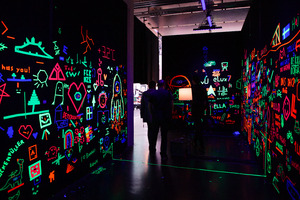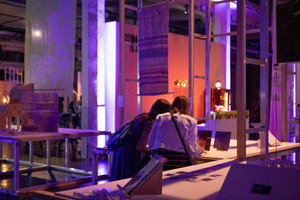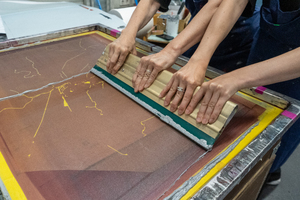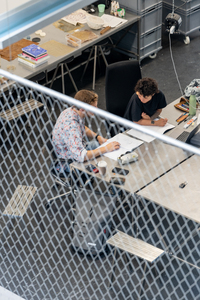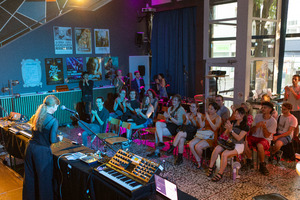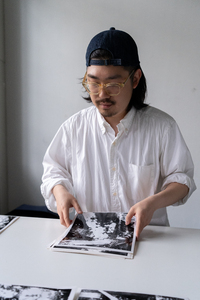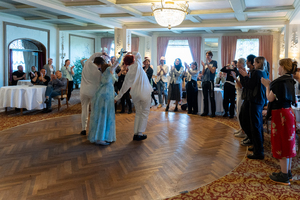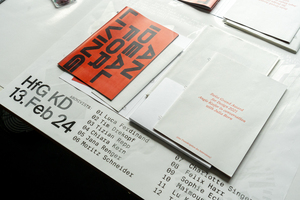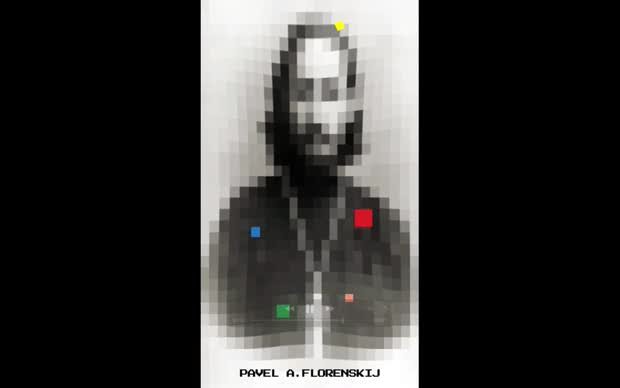Sets
234 Inhalte
- Seite 1 von 20
Interview
- Titel
- Interview
- Titel (en)
- Interview
- Beschreibung (de)
- In diesem Interview stellt der Absolvent seine Arbeit vor. Das Video ist Teil einer Serie von Interviews mit verschiedenen Absolvent*innen, die die HfG 2018 produzierte.
- Beschreibung (en)
- In this interview, the graduate presents his work. The video is part of a series of interviews with various graduates that the HfG produced in 2018.
- Titel
- Interview
- Importiert am
- 05.09.2024
- Übergeordnete Sets
- 0
- Set enthält
- 0 0
Gulaschprogrammiernacht 2024
- Titel
- Gulaschprogrammiernacht 2024
- Beschreibung (de)
- 22. Gulaschprogrammiernacht des Entropia e.V. in HfG und ZKM
Die Gulaschprogrammiernacht (GPN) des Entropia e.V. ist wieder bei uns zu Gast! In diesem Jahr steht sie unter dem Motto Common Code <> Different Roots. Die GPN ist eine offene, spendenfinanzierte Communityveranstaltung mit Vorträgen, Workshops, einer Demoshow, Musik und dem traditionellen Gulasch als Verpflegung.
30. Mai - 02. Juni 2024 in den Lichthöfen der HfG
"Gulaschprogrammiernacht" klingt fast wie ein Kochmarathon für schlaflose Informatikstudierende. Was 2002 in einem Karlsruher Kellerraum mit ein paar Technikbegeisterten angefangen hat, ist inzwischen zu einer der größten Veranstaltungen des Chaos Computer Clubs gewachsen. Die Themen sind breit gefächert: Den Kern bilden Hard- und Softwareentwicklung, sowie Datensicherheit. Daneben kommen aber auch Datenschutz, Netzpolitik und viele andere faszinierende Themen zum Zug: Wie kocht man das perfekte Gulasch? Kann man aus Hardwareschrott noch schönen Schmuck basteln? Wie funktioniert eigentlich eine Nähmaschine? Wie fliegt man Raumschiffe?
Die Gulaschprogrammiernacht wird vom Entropia e. V. des lokalen Chaos Computer Club in Karlsruhe veranstaltet. In den Lichthöfen der Hochschule für Gestaltung (HfG) und den Vortragssälen des Zentrum für Kunst und Medien (ZKM) werden mehr als 1.500 Besucherinnen und Besucher erwartet. Trotz der inhaltlichen Tiefe, in die manche Vortragende eintauchen, richtet sich die Gulaschprogrammiernacht nicht nur an die »Digital Natives« oder Nerds. Alle sind willkommen und können etwas lernen.
Das Programmieren steht im Zentrum der GPN. In den Lichthöfen der HfG stehen dazu im »Hackcenter« Tische mit Strom- und Netzwerkanschluss bereit, an denen die Gäste ihre Zelte aufschlagen können. Ein großer Teil reist mit einem Projekt an, um auf der Gulaschprogrammiernacht ein paar fokussierte Tage und gegebenenfalls auch Nächte damit zu verbringen. Das heißt nicht, dass kein Austausch stattfindet. Im Gegenteil: Die meisten Hackenden, wenn sie nicht gerade in tiefster Programmiermeditation versunken sind, geben gerne Auskunft über ihr Steckenpferd. Auch gerade Fertiggewordenes wird gerne vorgeführt, und so wimmelt es auf der Gulaschprogrammiernacht von selbstgebauten Lichtinstallationen und Gerätschaften.
Der zweite Hauptbestandteil einer Gulaschprogrammiernacht - neben den Aktivitäten im Hackcenter - ist das Workshop- und Vortragsprogramm. Von tief in die Materie gehenden Vorträgen aus Hard- und Softwareentwicklung über lehrreiche (und humorvolle) Anekdoten aus dem alltäglichen Programmierwahnsinn bis zu netzpolitischen Debatten ist alles vertreten. Bei Löt- und Bastelworkshops können Elektronik-Skills verbessert werden, Lightning Talks bieten eine offene Bühne für spontane Kurzvorträge, und auch die Demoszene erfreut sich stets großer Beliebtheit.
Das diesjährige Motto ist "Common Code <> Different Roots". Es gibt viel "Common Code", den wir jeden Tag in unserem digitalen und analogen Leben nutzen. Wo liegen die Wurzeln dieser Codes? Wie arbeiten sie zusammen? Wie wächst daraus ein Baum? Was ist mit der Community hinter dem Code? Wie sieht die Zukunft unseres Baumes aus?
Die Gulaschprogrammiernacht ist eine offene Veranstaltung für alle. Eine vorherige Anmeldung ist erwünscht, eine Spende wird erbeten.
- 22. Gulaschprogrammiernacht des Entropia e.V. in HfG und ZKM
- Beschreibung (en)
- 22. Gulaschprogrammiernacht of Entropia e.V. in HfG and ZKM
The Goulash Programming Night (GPN) of Entropia e.V. is back with us! This year's motto is Common Code <> Different Roots. The GPN is an open, donation-financed community event with talks, workshops, a demo show, music and the traditional goulash for refreshments.
May 30 - June 02, 2024 in the atriums of the HfG
“Goulash programming night” almost sounds like a cooking marathon for sleepless computer science students. What started in 2002 in a basement room in Karlsruhe with a few technology enthusiasts has now grown into one of the Chaos Computer Club's biggest events. The topics are wide-ranging: The core is hardware and software development, as well as data security. However, data protection, network policy and many other fascinating topics are also covered: How do you cook the perfect goulash? Can you make beautiful jewelry out of hardware scrap? How does a sewing machine actually work? How do you fly spaceships?
The Goulash Programming Night is organized by Entropia e. V. of the local Chaos Computer Club in Karlsruhe. More than 1,500 visitors are expected in the atriums of the University of Arts and Design (HfG) and the lecture halls of the Center for Art and Media (ZKM). Despite the depth of content that some of the speakers will delve into, the Goulash Programming Night is not just aimed at “digital natives” or nerds. Everyone is welcome and can learn something.
Programming is at the heart of the GPN. Tables with power and network connections are set up in the “Hackcenter” in the atriums of the HfG, where guests can pitch their tents. A large number of people travel to the Goulash Programming Night with a project to spend a few focused days and even nights working on it. This does not mean that there is no exchange. On the contrary: most hackers, when they are not immersed in deepest programming meditation, are happy to provide information about their hobbyhorse. They also like to show off what they have just finished, and so the Goulash Programming Night is teeming with self-built light installations and devices.
The second main component of a Goulash Programming Night - in addition to the activities in the Hackcenter - is the workshop and lecture program. From in-depth lectures on hardware and software development to instructive (and humorous) anecdotes from everyday programming madness and debates on net politics, everything is represented. Electronics skills can be improved at soldering and tinkering workshops, lightning talks offer an open stage for spontaneous short presentations, and the demo scene is always very popular.
This year's motto is “Common Code <> Different Roots”. There is a lot of “common code” that we use every day in our digital and analog lives. Where are the roots of these codes? How do they work together? How does a tree grow from it? What about the community behind the code? What does the future of our tree look like?
The Goulash Programming Night is an open event for everyone. Prior registration is required, a donation is requested.
- 22. Gulaschprogrammiernacht of Entropia e.V. in HfG and ZKM
- Datierung
- 30.05.2024 - 02.06.2024
- Ort: Institution
- Internetlinks
- Titel
- Gulaschprogrammiernacht 2024
- Importiert am
- 30.08.2024
- Übergeordnete Sets
- 1
- Set enthält
- 0 12
KAMUNA 2024
- Titel
- KAMUNA 2024
- Untertitel
- Karlsruhe Museumsnacht
- Beschreibung (de)
- Die HfG ist in diesem Jahr zum zweiten Mal als offizieller Partner Teil der Karlsruher Museumsnacht KAMUNA mit einem eigenen Programm in den Lichthöfen.
Am 3. August 2024 öffnen wir ab 18.00 Uhr die Türen mit folgenden Highlights:
Ausstellung: Aktuelle Arbeiten von Studierenden und Projekte aus den Studiengängen Ausstellungsdesign und Szenografie, Kommunikationsdesign, Kunstwissenschaft und Medienphilosophie, Medienkunst sowie Produktdesign der HfG in Lichthof 3+4.
Ausstellung: Ausgewählte Ergebnisse des HfG-Schnupperstudiums, die Schülerinnen und Schüler zwischen 16 und 20 Jahren in Workshops 5 Tage lang kreativ erarbeitet haben in Lichthof 3+4.
Robotic Soundscape: Interactive Robotic Sound Art Performance mit dem Maschinenkunst-Pionier und Medienkünstler Kal Spelletich - Eine Gruppenperformance von Nachwuchskünstlerinnen und -künstlern der HfG mit einem Maschinenorchester aus interaktiven Klangrobotern, elektromechanischen Klangerzeugern und automatischen Instrumenten exklusiv für die KAMUNA. Beeinflusst von der Arbeit von Terry Riley, Kraftwerk, David Tudor, John Cage, den Einstürzenden Neubauten und Pauline Oliveros wird eine einzigartige Soundscapekomposition erschaffen. Dies ist die seltene Gelegenheit, eine von Kal Spelletichs Performances zu erleben. Aufführungen um 20 Uhr und um 21 Uhr im großen Studio
Illuminating Nature: Interaktiver Workshop über (biolumineszente) Pilze - Das Bio Design Lab an der HfG und das Hertzlab am ZKM weihen in diesem praktischen Crossover-Projekt in die wilde Welt der organischen Netzwerke der Pilze ein. Praktische Hands-on Performance mit dem biolumineszierenden Myzelium des Herben Zwergknäuelings (Panellus stipticus) plus Wissenswertes über Pilze als Nutzorganismen und warum sie sich so gut für Medienkunst eignen. 21:00 - 0:00 im Bio Design Lab in Lichthof 4.
Gemeinsame Ausstellung von HfG und ZKM: Antennae: Frequencies from the Archive - Entwickelt von einer Seminargruppe des Studiengangs Ausstellungsdesign und Szenografie der HfG und kuratiert von Nick Aikens, Céline Condorelli im Dialog mit Felix Mittelberger.
Gemeinsame Studio-Ausstellung von HfG und Städtischer Galerie Karlsruhe: „Hydromedia. Seeing with Water“ - Erarbeitet im Frühjahr 2024 an der HfG Karlsruhe im Rahmen des EU-geförderten künstlerischen Forschungsprojekts „Hydromedia“
- Die HfG ist in diesem Jahr zum zweiten Mal als offizieller Partner Teil der Karlsruher Museumsnacht KAMUNA mit einem eigenen Programm in den Lichthöfen.
- Beschreibung (en)
- This year, the HfG is part of the Karlsruhe Museum Night KAMUNA for the second time as an official partner with its own program in the atriums.
On August 3, 2024, we will open the doors from 6 p.m. with the following highlights
Exhibition: Current works by students and projects from the exhibition design and scenography, communication design, art studies and media philosophy, media art and product design courses at the HfG in Lichthof 3+4
Exhibition: Selected results of the HfG taster course, which students between the ages of 16 and 20 worked on creatively in workshops over 5 days in Lichthof 3+4
Robotic Soundscape: Interactive Robotic Sound Art Performance with machine art pioneer and media artist Kal Spelletich - A group performance by young artists from the HfG with a machine orchestra of interactive sound robots, electromechanical sound generators and automatic instruments exclusively for KAMUNA. Influenced by the work of Terry Riley, Kraftwerk, David Tudor, John Cage, Einstürzende Neubauten and Pauline Oliveros, a unique soundscape composition will be created. This is a rare opportunity to experience one of Kal Spelletich's performances. **Performances at 8 pm and 9 pm in the Studio.
Illuminating Nature: An Interactive Workshop on (Bioluminescent) Fungi - The Bio Design Lab at the HfG and the Hertzlab at the ZKM will introduce you to the wild world of organic fungal networks in this practical crossover project. In a practical hands-on performance, we will bring the bioluminescent mycelium of the Panellus stipticus into your living room. Along the way you will learn interesting facts about fungi as useful organisms and why fungi are so well suited for media art. Time: 21:00 - 0:00 at the Bio Design Lab in Lichthof 4.
Joint exhibition by HfG and ZKM: Antennae: Frequencies from the Archive - Developed by a seminar group from the exhibition design and scenography course at HfG and curated by Nick Aikens, Céline Condorelli in dialog with Felix Mittelberger.
Joint studio exhibition by HfG and Städtische Galerie Karlsruhe: “Hydromedia. Seeing with Water” - Developed in spring 2024 at the HfG Karlsruhe as part of the EU-funded artistic research project ”Hydromedia”
- This year, the HfG is part of the Karlsruhe Museum Night KAMUNA for the second time as an official partner with its own program in the atriums.
- Datierung
- 03.08.2024
- Ort: Institution
- Internetlinks
- Titel
- KAMUNA 2024
- Importiert am
- 30.08.2024
- Übergeordnete Sets
- 1
- Set enthält
- 0 23
Dusting. Ecosystems with images and codes
- Titel
- Dusting. Ecosystems with images and codes
- Titel (en)
- Dusting. Ecosystems with images and codes
- Beschreibung (en)
- “No matter how desperately you fight against it, dust pervades everything. It accumulates in fuzzy balls or gathers in even layers, adapting to the contours of things and making the passage of time. In itself, it is also a gathering place, a random community of what has been and what is yet to be, a catalog of traces, an inventory of threats, and a set of promises… “ Michael Marder, “Dust” 2016 In this seminar we will look at different situations with images and codes where dust engages as a medium to understand the complex interrelation between the content of an image and its making, its meta-data and its technological and ecological being in the world. The seminare is practical as well as theoretical. We will dust together, and we will wait for dust to settle: on paper, in space, in our minds, and we will research and engage in dust experiments together: from field trips to laboratory visit to exhibition visits. At the end of the seminar the aim is to have delevoped a presentation, be it an image series, an installation, or/ and a research exhibition. This will be presented during the Rundgang. Prof. Susanne Kriemann organises an excursion to Vienna 24th to 27th of April to see the exhibition “Into the Woods” at KunstHausWien and the first “Klima-Biennale”.
- Typ des Projekts/Werks
- Datierung
- 30.04.2024 - 16.07.2024
- Titel
- Dusting. Ecosystems with images and codes
- Projektleiter/in
- Semester
- Studiengang
- Importiert am
- 22.08.2024
- Übergeordnete Sets
- 1
- Set enthält
- 0 25
Ghosts of Grand Hotels 2024
- Titel
- Ghosts of Grand Hotels 2024
- Titel (en)
- Ghosts of Grand Hotels 2024
- Untertitel
- Ausstellung der Seminararbeiten
- Beschreibung (de)
- Willkommen im Grand Hotel, liebe Passagiere! Das Reisebüro Ghostly Matters bietet Ihnen eine saisonale Fahrt durch die weite, unheilvolle Landschaft des Schwarzwalds mitten in das Herz eines ehemaligen Grandhotels: Waldlust. Seine offenen Türen verbreiten den einzigartigen Duft von Urlaub, Klassizismus, Kunst und Luxus. Entdecken Sie mit uns die unerzählten Erzählungen seiner Wände, Möbel, Küche, Mitarbeiter und Gäste, die das Internationale mit dem Lokalen verbinden. Welche Spuren hinterlassen sich nach dem Verlassen der Zimmer im Hotel? Unser Team empfängt Sie am 5. Juli in Freudenstadt zu einem außergewöhnlichen Besuch der Ausstellungsstätte Waldlust. Die kommende Ausstellung ist die Fortsetzung einer kritischen und spielerischen Auseinandersetzung mit dem Erbe und dem zeitgenössischen Status von Grand Hotels. Welche Geister verfolgen uns in den Räumen des klassizistischen und kolonialen Luxus, in den Kammern der Fürsorge und Gastfreundschaft und in den Treffpunkten von Künstlern und wohlhabendem Bürgertum? Welche Zukünfte könnten aus einem Pool verschiedener Zeitlichkeiten entstehen? Die Ausstellung ist eine Kooperation zwischen Waldlust e.V., HfG Karlsruhe, ABK Stuttgart und Hochschule Offenburg.
- Beschreibung (en)
- Welcome to Grand Hotel, dear passengers! The travel agency Ghostly Matters offers you a seasonal ride through the vast, ominous landscape of the Black Forest right into the heart of a former Grand Hotel: Waldlust. Its open doors are spreading the unique odor of holidays, classism, art and luxury. Discover with us the untold narratives of its walls, furniture, kitchen, employees and guests, that merged the international and the local. Which traces are inscribed in the hotel after the rooms are left? Our Team will welcome you on the 5th of July in Freudenstadt for a remarkable visit to the exhibition setting at Waldlust. The upcoming exhibition is the continuation of a critical and playful exploration on the legacy and contemporary status of grand hotels. Which ghosts are haunting us in the spaces of classicist and colonial luxury, the chambers of care work and hospitality and meeting places of artists and wealthy bourgeoisie? Which futures could emerge out of a pool combining various temporalities? The exhibition is a collaboration between Waldlust e.V., HfG Karlsruhe, ABK Stuttgart and Hochschule Offenburg.
- Kategorie
- Typ des Projekts/Werks
- Datierung
- 25.04.2024 - 31.07.2024
- Mitwirkende
- Ort: Institution
- Ort
- Hotel Waldlust Freudenstadt
- Stadt
- Land
- Beteiligte Institution(en)
- Titel
- Ghosts of Grand Hotels 2024
- Projektleiter/in
- Semester
- Studiengang
- Lehrveranstaltung
- Importiert am
- 22.08.2024
- Übergeordnete Sets
- 1
- Set enthält
- 0 11
KD Vordiplomspräsentation SS 2024
- Titel
- KD Vordiplomspräsentation SS 2024
- Kategorie
- Datierung
- 04.07.2024
- Ort: Institution
- Stadt
- Land
- Titel
- KD Vordiplomspräsentation SS 2024
- Urheberrechtshinweis
- © Staatliche Hochschule für Gestaltung Karlsruhe
- Semester
- Studiengang
- Typ der Abschlussarbeit
- Importiert am
- 22.08.2024
- Übergeordnete Sets
- 0
- Set enthält
- 0 11
G.O.T.T.A.L.I.S.T.E.N.
- Titel
- G.O.T.T.A.L.I.S.T.E.N.
- Autor/in
- Beschreibung (de)
- "GOTTALISTEN", kurz für „Grab One Terrene Thought And Let It Slide To Eternal Nothingness”, beschäftigt sich mit der Zeit der Oktoberrevolution in Russland im Jahr 1917. Die Klebeband-Leinwände nehmen Bezug auf den Künstler Kasimir Malewitsch, der während dieser Epoche in Russland lebte. Zudem setzt Claus sich mit dem russischen Religionsphilosoph, Priester, Mathematiker und Kunstwissenschaftler Pavel Florenskij auseinander.
- Beschreibung (en)
- "GOTTALISTEN", short for "Grab One Terrene Thought And Let It Slide To Eternal Nothingness", deals with the time of the October Revolution in Russia in 1917. The tape canvases refer to the artist Kasimir Malewitsch, who lived in Russia during this era. Claus also deals with the Russian religious philosopher, priest, mathematician and art historian Pavel Florenskij.
- Kategorie
- Schlagworte
- Titel
- G.O.T.T.A.L.I.S.T.E.N.
- Projektleiter/in
- Semester
- Studiengang
- Typ der Abschlussarbeit
- Importiert am
- 08.08.2024
- Übergeordnete Sets
- 0
- Set enthält
- 1 27
